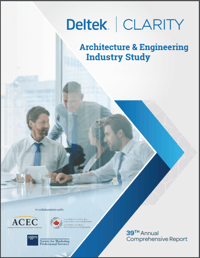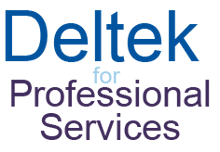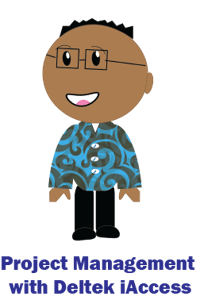The 39th Annual Deltek A/E Clarity Report is Now Available
 Each year Deltek conducts a survey of firms in the architecture and engineering industry to identify key issues impacting the market, highlight bright spots, and forecast future trends. Guided by industry experts, the survey focuses on financial statements, business development, project management, human capital management, and technology trends. This year, in total, 952 individuals took the survey, and nearly 450 companies provided input. Firms in this study are of varying sizes and headquartered across the US and Canada.
Each year Deltek conducts a survey of firms in the architecture and engineering industry to identify key issues impacting the market, highlight bright spots, and forecast future trends. Guided by industry experts, the survey focuses on financial statements, business development, project management, human capital management, and technology trends. This year, in total, 952 individuals took the survey, and nearly 450 companies provided input. Firms in this study are of varying sizes and headquartered across the US and Canada.
Key Findings in This Year’s Deltek A/E Clarity Report
Financial Statements
Firms’ financial statements reveal year-over-year stability in the industry, with most impacts appearing to be driven by talent management and staffing changes.
- Average operating profit on net revenue was 13.2%, up just slightly from last year’s 13% and the previous year’s 12.8%.
- Utilization rates dropped slightly to 59.4% from 60.0% last year.
- The net labor multiplier saw a decrease to an average of 2.96, down quite significantly from a spike of 3.02 last year and back in line with 2015.
- Firms reversed a five-year decline in overhead rate, increasing from 154% to 155%.
- The average collection period dropped by one day to 71 days, although high performers increased by two days to a 67-day average.
Business Development
Firms are looking to diversify opportunities and their business development efforts to stay ahead in a competitive market.
- Net revenue growth forecast was 5.2%, down just slightly from last year’s 5.3%.
- Firms are using a diverse array of staff for business development, with 19% of firms using dedicated business development staff only, 31% sellers/doers only, and 50% using a mixture of both. However, only 46% of firms had a formal business development process for their staff.
- Win rates improved to 50.0%, rising 9.8 percentage points from last year’s 40.2%.
- The percentage of firms with a formal go/no-go process decreased from 75% last year to 67% this year.
- More firms expect growth in surveying/geographic information systems (GIS), transportation, and commercial markets than any other industry, whereas nearly 60% of firms expect their position to stay the same or decline in the residential, education, and hospitality markets.
Project Management
Firms need to continue to focus on improving the project management discipline and increasing client satisfaction.
- Two-thirds of all firms have a high level of visibility on cost variance, whereas more than half of all firms stated that they had low or moderate visibility into schedule variance and client satisfaction. Compared to last year, client satisfaction visibility decreased from 53% to 45%.
- Firms this year reported that 20% of their projects were over budget and 25% of their projects were behind schedule.
- Sixty-one percent of firms had high confidence in their overall project reporting abilities, down from 72% last year. More than 90% of firms felt confident they were accurately reporting the actual cost and budget of their projects, whereas only 69% of firms felt the same about the accuracy of their schedule reporting.
- In terms of discipline maturity, only 47% of firms used a formal project management process for three-fourths or more of their projects. Overall, 18% of firms had a PMO or center of excellence. Additionally, only 39% of firms have less than one-quarter of staff with formal project management training.
- Eighty-one percent of firms are measuring client satisfaction, and of these firms, 45% are conducting these measures for all projects and 49% for strategic projects only. The majority are measuring client satisfaction irregularly, compared to 22% of firms that do so at key project milestones.
Human Capital Management
Firms are experiencing growth, but employee turnover—particularly voluntary turnover—has increased, making staff retention and improved talent acquisition imperative.
- Staff growth is 4.3%, declining from 6.9% last year.
- Employee turnover increased to 12.8%, up from 11% last year.
- 34% of firms had more open positions, compared with only 15% with fewer open positions.
- The average time to fill positions was 31–60 days, although for 15% of firms, it takes an average of 90 or more days to fill positions. Compared to last year, there was a 7-percentage-point decrease in firms that filled positions in less than 30 days.
- Of all firms, 43% have a formal succession plan. For 68% of firms, their succession plan applies only to current leaders and next-in-line leaders, whereas for 7% it applies to all employees.
Technology Trends
In the first year tracking technology trends, firms are looking for better ways to collect data that can be leveraged for strategic decisions.
- Geolocation and the Internet of Things (IoT) were the most important technology trends.
- Most firms did not rank artificial intelligence (AI) or wearable technology as technology trends they are focused on, but it can significantly change the way we run our businesses when the time is right.
Benchmark Your Firm with the Deltek A/E Clarity Report
While these are the highlights of the 39th Annual Deltek A/E Clarity study, the report goes into much more detail. Using these results, you can see how your firm has been doing not only compared to your previous year, but also to other comparable firms in your industry. With these industry insights, you can develop future goals to help your firm stand out against the growing wave of competition. For an in-depth view of everything included in the 39th Annual Deltek A/E Clarity report, download your copy today.



 Attending a professional conference is a great way to learn solutions to obstacles you currently face, new ways to challenge yourself, and learn about trends in your industry. Additionally, you should never hesitate to ask your employer to allow you to attend a good and relevant conference on their dollar. Furthermore, managers should require employees to go to professional conferences to get out of the office and learn new things they can bring back to share with their coworkers. So, what are the benefits of attending a professional conference?
Attending a professional conference is a great way to learn solutions to obstacles you currently face, new ways to challenge yourself, and learn about trends in your industry. Additionally, you should never hesitate to ask your employer to allow you to attend a good and relevant conference on their dollar. Furthermore, managers should require employees to go to professional conferences to get out of the office and learn new things they can bring back to share with their coworkers. So, what are the benefits of attending a professional conference?
 With repetitive sourcing for candidates, constant scheduling, and continuous boilerplate interviews, recruiting and hiring has become very mechanical in nature. It should instead be focused on discovering the best talent fit for the company culture and be done in a more strategic and efficient way. To accomplish this, recruiters need to improve their methods which have often been unknowingly biased, think outside the box, and find ways to streamline the recruiting and hiring process for quality talent. Let’s check out the top 4 recruiting trends.
With repetitive sourcing for candidates, constant scheduling, and continuous boilerplate interviews, recruiting and hiring has become very mechanical in nature. It should instead be focused on discovering the best talent fit for the company culture and be done in a more strategic and efficient way. To accomplish this, recruiters need to improve their methods which have often been unknowingly biased, think outside the box, and find ways to streamline the recruiting and hiring process for quality talent. Let’s check out the top 4 recruiting trends.
 By now, you’ve probably heard about Deltek for Professional Services (DPS), but how does the next generation Deltek product help your firm? To answer this question, it’s easiest to break down the firm into its key roles and show the benefits of DPS to each of them. So, role by role, let’s look at the top 5 benefits of DPS.
By now, you’ve probably heard about Deltek for Professional Services (DPS), but how does the next generation Deltek product help your firm? To answer this question, it’s easiest to break down the firm into its key roles and show the benefits of DPS to each of them. So, role by role, let’s look at the top 5 benefits of DPS.
 Many people don’t realize that talent management is a key business strategy and is vital to a firm’s success. It begins with recruiting potential hires and follows employees throughout their entire life cycles with a firm. Since talent management has such a great financial impact on a firm, talent metrics should be used to show return on investment and to make informed business decisions. So, which metrics are the most significant?
Many people don’t realize that talent management is a key business strategy and is vital to a firm’s success. It begins with recruiting potential hires and follows employees throughout their entire life cycles with a firm. Since talent management has such a great financial impact on a firm, talent metrics should be used to show return on investment and to make informed business decisions. So, which metrics are the most significant? Many firms have a plethora of data regarding existing clients, prospects, and wins and losses just sitting around being underutilized or possibly not being used at all. So, what should these firms be doing with all this data? Well, this significant information needs to be analyzed to create actionable insights which will help drive business development decisions. Here are some thoughts to ensure a proper data analysis.
Many firms have a plethora of data regarding existing clients, prospects, and wins and losses just sitting around being underutilized or possibly not being used at all. So, what should these firms be doing with all this data? Well, this significant information needs to be analyzed to create actionable insights which will help drive business development decisions. Here are some thoughts to ensure a proper data analysis. Many firms in the architectural and engineering (A&E) industry are using mergers and acquisitions (M&A) as a strategy to grow. As discussed previously in a
Many firms in the architectural and engineering (A&E) industry are using mergers and acquisitions (M&A) as a strategy to grow. As discussed previously in a 
 With all the hot topics of last year, we thought it would be interesting to see which ones were valued the most by Deltek Users. To figure this out, we compiled a list of the top 10 read Full Sail Partners’ blogs of 2017. From finance, to marketing, to HR, to project managers, it seems that we offered a little something for everyone. Let’s check them out:
With all the hot topics of last year, we thought it would be interesting to see which ones were valued the most by Deltek Users. To figure this out, we compiled a list of the top 10 read Full Sail Partners’ blogs of 2017. From finance, to marketing, to HR, to project managers, it seems that we offered a little something for everyone. Let’s check them out:
 Mergers and acquisitions (M&A) in the architectural and engineering (A&E) industry are on the rise. Unfortunately, many firms are not prepared to successfully implement the M&A process. With an acquisition, it is imperative that the “buying” entity have a well-defined set of procedures to easily onboard the incoming firm. In the case of a merger, all involved firms would need a set plan which would dictate the transition to a new firm. However, first a firm must decide the direction it will take regarding the M&A process and evaluate how it will affect the current organization’s structure.
Mergers and acquisitions (M&A) in the architectural and engineering (A&E) industry are on the rise. Unfortunately, many firms are not prepared to successfully implement the M&A process. With an acquisition, it is imperative that the “buying” entity have a well-defined set of procedures to easily onboard the incoming firm. In the case of a merger, all involved firms would need a set plan which would dictate the transition to a new firm. However, first a firm must decide the direction it will take regarding the M&A process and evaluate how it will affect the current organization’s structure.
 “Project Controls” are formidable words, ones that are necessary for successful project outcomes. Those of you who have used Deltek Vision for many years may recall that “project controls” remain at the core of the Vision system and are the datacenter for all other Vision applications such as billing, CRM, proposals, resource planning, and time and expense. Fortunately for Vision users, accessing project controls has gotten a lot easier with Deltek iAccess.
“Project Controls” are formidable words, ones that are necessary for successful project outcomes. Those of you who have used Deltek Vision for many years may recall that “project controls” remain at the core of the Vision system and are the datacenter for all other Vision applications such as billing, CRM, proposals, resource planning, and time and expense. Fortunately for Vision users, accessing project controls has gotten a lot easier with Deltek iAccess.